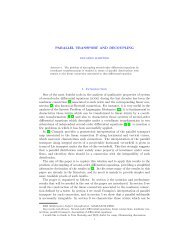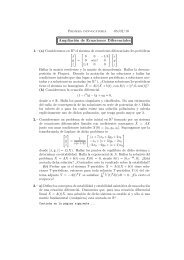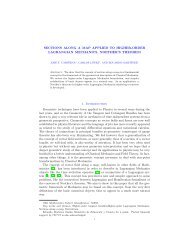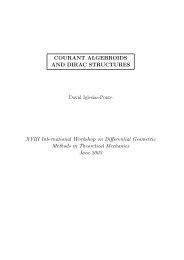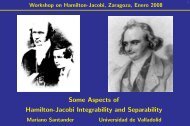TRANSFORMADA DE LAPLACE Estudiamos en este capítulo la ...
TRANSFORMADA DE LAPLACE Estudiamos en este capítulo la ...
TRANSFORMADA DE LAPLACE Estudiamos en este capítulo la ...
You also want an ePaper? Increase the reach of your titles
YUMPU automatically turns print PDFs into web optimized ePapers that Google loves.
La inversa de (s − A) es<br />
<strong>TRANSFORMADA</strong> <strong>DE</strong> <strong>LAPLACE</strong> 13<br />
(s − A) −1 =<br />
y su transformada inversa es<br />
e tA = L −1 =<br />
La solución del problema homogéneo es<br />
1<br />
(s + 1) 2 +22 �<br />
s +1<br />
�<br />
−4<br />
1 s +1<br />
�<br />
−t e cos(2t) −t −2e sin(2t)<br />
1<br />
2e−t sin(2t) e−tcos(2t) �<br />
−t e cos(2t) −t −2e sin(2t)<br />
1<br />
2e−t sin(2t) e−tcos(2t) 1<br />
(s + 1) 2 +2 2<br />
�<br />
=<br />
La solución particu<strong>la</strong>r del no homogéneo, se puede obt<strong>en</strong>er por medio de <strong>la</strong> integral<br />
de convolución (<strong>en</strong> <strong>este</strong> caso es muy fácil) o bi<strong>en</strong> por transformada de Lap<strong>la</strong>ce:<br />
(s − A) −1ˆ<br />
� �� �<br />
� �<br />
10<br />
s +1 −4<br />
b =<br />
s<br />
s +1<br />
=<br />
1 s +1 0<br />
1<br />
que es <strong>la</strong> transformada de Lap<strong>la</strong>ce de<br />
� 2+2e −t � − cos(2t) + 2 sin(2t) �<br />
2 − e −t� 2 cos(2t) + sin(2t) �<br />
� �<br />
4<br />
3<br />
�<br />
1<br />
(s + 1) 2 +22 10<br />
s<br />
La solución del problema es <strong>la</strong> suma de ambas. En g<strong>en</strong>eral, lo más s<strong>en</strong>cillo es<br />
hal<strong>la</strong>r directam<strong>en</strong>te <strong>la</strong> solución completa sin descomponer es suma de <strong>la</strong>s soluciones<br />
del homogéneo y particu<strong>la</strong>r del no homogéneo.<br />
(s − A) −1� X(0) + ˆ b � =<br />
=<br />
1<br />
(s + 1) 2 +2 2<br />
1<br />
(s + 1) 2 +2 2<br />
�<br />
� s +1 −4<br />
1 s +1<br />
�<br />
2 2(2s + s + 5)<br />
3s2 �<br />
+7s + 10<br />
y hal<strong>la</strong>ndo <strong>la</strong> transformada inversa obt<strong>en</strong>emos <strong>la</strong> solución<br />
� �<br />
x(t)<br />
=<br />
y(t)<br />
� 2+2e −t � cos(2t) − sin(2t) �<br />
2+e −t� cos(2t) + sin(2t) �<br />
�<br />
�� �<br />
10 4+<br />
Otra v<strong>en</strong>taja de <strong>la</strong> transformada de Lap<strong>la</strong>ce es que se puede aplicar igualm<strong>en</strong>te<br />
a sistemas de ecuaciones difer<strong>en</strong>ciales (lineales con coefici<strong>en</strong>tes constantes) <strong>en</strong> los<br />
que cada variable ti<strong>en</strong>e un ord<strong>en</strong> distinto.<br />
Ejemplo 4.6: Consideremos el sistema de ecuaciones difer<strong>en</strong>ciales<br />
� ¨x +2y =0<br />
˙x +˙y = cos t<br />
Resolvamos dichas ecuaciones con condiciones iniciales x(0) = 0,y(0) = 0, ˙x(0) =<br />
2. La transformada del Lap<strong>la</strong>ce del sistema, una vez sustituidas <strong>la</strong>s condiciones<br />
iniciales es<br />
s 2 X +2Y =2 sX − sY = s<br />
s 2 +1<br />
cuya solución es<br />
X(s) = 2<br />
s2 Y (s) =<br />
+1<br />
1<br />
s2 +1 .<br />
Hal<strong>la</strong>ndo <strong>la</strong> antitransformada, <strong>la</strong> solución es<br />
x(t) = 2 sin t y(t) = sin t.<br />
Como ejercicio, y para compara <strong>la</strong> dificultad, se propone resolver el problema anterior<br />
sin utilizar <strong>la</strong> transformada de Lap<strong>la</strong>ce. ⊳<br />
3<br />
s<br />
⊳




